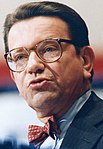1990 United States Senate election in Illinois
The 1990 United States Senate election in Illinois was held on November 6, 1990. Incumbent Democratic U.S. Senator Paul Simon sought re-election to a second term in office. Simon was opposed by Republican nominee Lynn Morley Martin, a U.S. Congresswoman from Illinois's 16th congressional district, whom he easily defeated to win a second and final term in the Senate.
| |||||||||||||||||
| Turnout | 53.90% | ||||||||||||||||
|---|---|---|---|---|---|---|---|---|---|---|---|---|---|---|---|---|---|
| |||||||||||||||||
Simon: 50–60% 60–70% 70–80% 80–90% >90% Martin: 50–60% 60–70% 70–80% Tie: 50% | |||||||||||||||||
| |||||||||||||||||
Primaries were held March 20, 1990.[1]
Background
editThe primaries and general elections coincided with those for House, as well as those for state offices.
For the primaries, turnout was 23.02%, with 1,384,324 votes cast.[1] For the general election, turnout was 53.90%, with 3,251,005 votes cast.[2]
Democratic primary
edit| Party | Candidate | Votes | % | |
|---|---|---|---|---|
| Democratic | Paul Simon (incumbent) | 811,329 | 100.00% | |
| Total votes | 811,329 | 100.00% | ||
Republican primary
edit| Party | Candidate | Votes | % | |
|---|---|---|---|---|
| Republican | Lynn Martin | 572,995 | 100.00% | |
| Total votes | 572,995 | 100.00% | ||
General election
editCandidates
edit- Paul Simon (D), incumbent United States Senator
- Lynn Morley Martin (R), United States Congresswoman from Illinois's 16th congressional district
Election
editAt the start of the election, Martin was considered a formidable challenger, but her campaign floundered – in ads, Martin poked fun at Simon's signature bow tie, but the ad campaign, an attempt at humor, was seen by some as petty and mean-spirited. Martin's campaign suffered from poor fundraising as well, being outspent by Simon by a margin of two-to-one. Simon's popularity proved too much to overcome, and he won with 65 percent of the vote, carrying all but two counties in the state; Edwards County in the southeast and McHenry County outside Chicago, in the heart of the district Martin represented for most of the 1980s. In a midterm favorable to Democrats, Martin was further hurt by negative campaign tactics deployed by advisor Roger Ailes, as well as a number of gaffes. Including, referencing downstate voters as "rednecks".[3] Martin raised the most campaign funds out of any Republican Senate challenger that cycle.[3]
Results
edit| Party | Candidate | Votes | % | ±% | |
|---|---|---|---|---|---|
| Democratic | Paul Simon (incumbent) | 2,115,377 | 65.07% | +15.00% | |
| Republican | Lynn Martin | 1,135,628 | 34.93% | −13.28% | |
| Total votes | 3,251,005 | 100.00% | N/A | ||
| Democratic hold | |||||
See also
editReferences
edit- ^ a b c d Michaelson, Ronald D. (Executive Director) (June 13, 1990). "Official Vote Cast at the Primary Election Held on March 20, 1990". Illinois State Board of Elections. p. 16. Retrieved June 17, 2024 – via Internet Archive.
- ^ a b Michaelson, Ronald D. (Executive Director) (January 17, 1991). "Official Vote Cast at the General Election November 6, 1990". Illinois State Board of Elections. Retrieved June 17, 2024 – via Internet Archive.
- ^ a b Oreskes, Michael (October 19, 1990). "High Hopes of Defeating Simon Are Being Deflated". The New York Times. Retrieved June 17, 2024.
- ^ Dendy, Dallas L. "Statistics of the Congressional Election of November 6, 1990" (PDF).



